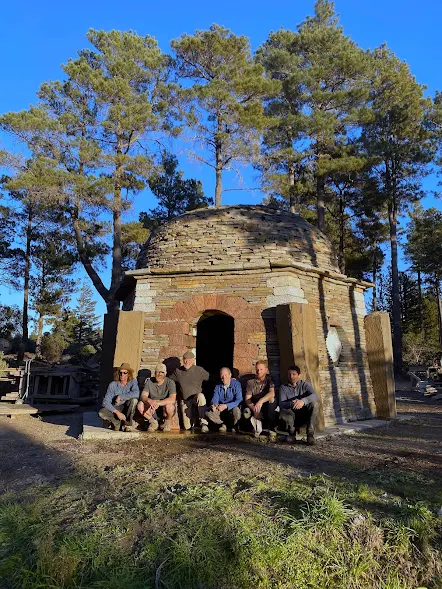Recently on Instagram I posted a photo of the Temple of Imperfections. I explained in the text that the installation was called the Temple of Imperfections, because of all the many imperfections that can still result in a kind of perfection that can't be achieved any other way.
We imagine that the almost imperceptible, deviations from perfectly level, perfectly straight, perfectly curved , perfectly this or that, may all serendipitously mesh together and cancel each other.
I would venture to say there isn't an imperfection that can't be corrected with another. While there may be many planned attempts at correcting something so that it nears perfection, there is still the likelihood the 'imperfect fix' might actually create something closer to perfection, than the over-planned, tightly prescribed, uncompromising fix.
When laying stones, it is possible to come to what we would accept as 'perfectly level', by having stacked that course of stones along the top of several rows of stones below, that were decidedly, 'off level'.
In writing now, in several blog instalments, about how the temple came to be made, and about this concept of accumulative imperfections, I realize that it is a kind of nod to (as well as a bit of a departure from) the Japanese aesthetic of wabi-sabi.
Richard Powell, author of Wabi Sabi Simple, tells us -"wabi-sabi nurtures all that is authentic, by acknowledging three simple realities: nothing lasts, nothing is finished, and nothing is perfect", and that imperfections are to be appreciated as part of life.
Imperfections in fact, within a craft such as dry stone walling, can create works that actually exceed the level of 'correctness' we were striving for.
They (imperfections) may not just have to be 'accepted', but in fact be anticipated, as making the perfection of the thing seem very close
In the process of trying to build the temple we tried to embrace this idea as we strived (and yet more importantly 'chilled' ) about the perceived allowable tolerances that were needed to attain a certain aesthetic perfection. In the process we saw a wonderful thing happening. A kind of self-fulfilling happenstance. Combinations of self-cancelling discrepancies 'happened' enough times that we almost came to expect them.
It was this aspect of the temple building that led us to come up with the name. At first I suggested it be called - The temple of Imperfection (singular) but Sean said that wasn't quite right. (it was imperfect? ) The temple, however, with all our hard work measuring, cutting and fitting, was not completely imperfect. If anything it was incompletely perfect, (ie. made up of lots of imperfections). And so we agreed to call it the Temple of Imperfections.
Sean Adcock measuring and remeasuring and allowing for imperfection
And here I venture into the second wabi-sabi principle. The reality that in life, nothing is complete. Nothing in the universe including 'creation', and 'creativity', is finished!
This would seem true of the build we started at the Stonezone, in California , in 2019, as the project has been spread over a period of four years, with building sessions lasting three or four weeks each year, so far. And, here's the thing - it still isn't finished. There is so much waiting to be done, yet.
But it certainly looks finished. Is this just happenstance? The thing that has certainly happened , has become and is becoming, an accumulation of 'incompletenesses' ( word ?) and yet in a very real way it has attained a feeling of completeness.
The third reality of the temple (and in wabi-sabi) is that everything is impermanent. Even though we are working with what is essentially permeant stone material, granite, mica schist, basalt sandstone and marble, and we know that it is not going to last. But for all extensive purposes it will outlast (outlive?) a lot of other things. And here's the thing. It will outlast all our impermanence.
Those of us who worked and continue to work on the temple are temporal. We wallers and masons and sculptors have gathered together as a dedicated group of impermanent mortals. And yet all our accumulative impermanences have ironically created something very lasting.
Again the three principles of Wabi Sabi are - nothing is perfect, nothing is completely finished, and nothing is permanent somehow accommodate our understanding of the essence of the temple. It could have been called the Temple of Wabi-Sabi because the structure exists as a kind of accumulation of the realities of life -Imperfection, Incompleteness, Impermanence. And if the universe embraces these three naturally occurring, what shall we call them, limitations? ironies? conundrums? discrepancies?... then so do we!
My hope is that the temple, may, with its myriad of discrepancies, given time, and skill, (if they don't already, eventually) all cancel each other and create a very satisfyingly balanced result.


